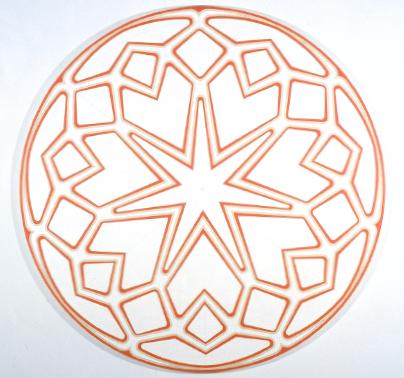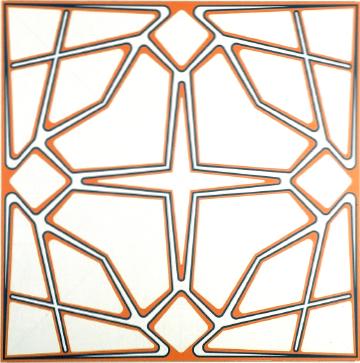Excerpt from Young + Brash + Abstract
Henry Brown both draws and paints in a single work. Because he doesn't remove the drawing or schematic plan from the painting, his work exists on two distinct yet interconnected levels. In each painting, he uses the schematic he has drawn to generate what will become the painted image. And yet, the connection between the schematic and the image never feels obvious or literal. There is nothing mechanistic about what happens after the drawing is complete. Obsessive and systemic, the drawing functions as a springboard; it enables Brown to make an imaginative, unexpected leap.
In Brown’s paintings, the viewer sees the plotted pencil lines and painted image, but the relationship between the two refuses to spell itself out. The viewer is left pondering the gap between the two. These gaps remind us that thinking is not linear, that a series of leaps and sudden insights can occur. The viewer is also faced with questions: When is something truly independent and when is something truly dependent? At one point does coexistence occur? Are these states fixed or are they always changing? Such questions make it apparent that Brown has introduced contingency into the realm of geometry. And in doing so, he has made the viewer aware that geometry itself is not necessarily a stable or a closed system, and its instability may enable it to gain a generative power.

As a tondo with a central, radiating, star-like, geometric image, Interlock, 2001, recalls stained-glass windows. At the same time, the flatly painted, diamond-like configurations surrounding the star-like image cause the picture plane to appear to be bending slightly, like a bubble. This illusionism destabilizes the painting by transforming what seems to be a flat, static image into something in a state of change. This aspect of Brown’s work distinguishes him from previous generations of geometric artists. His geometry is animated; each state, including that defined by one of his paintings, is temporary. For example, Reversal, 2001, seems like it has just unfolded itself before our eyes.

The realization that there is nothing under the sun that is fixed is something Brown shares with the other artists I have written about, Kathleen Kucka, Walter Biggs, and Jennifer Riley. Certainly, in sharing this understanding of reality, they define an open-ended mode of investigation. In undertaking an open-ended inquiry, Brown doesn't convey optimism as much as faith. He believes that paint will take him somewhere. Process, rather than product, is what is important.
—John Yau
John Yau and Ted Potter. Young + Brash + Abstract. Richmond: Anderson Gallery, Virginia Commonwealth University, 2002. ISBN: 0–935519–25–4